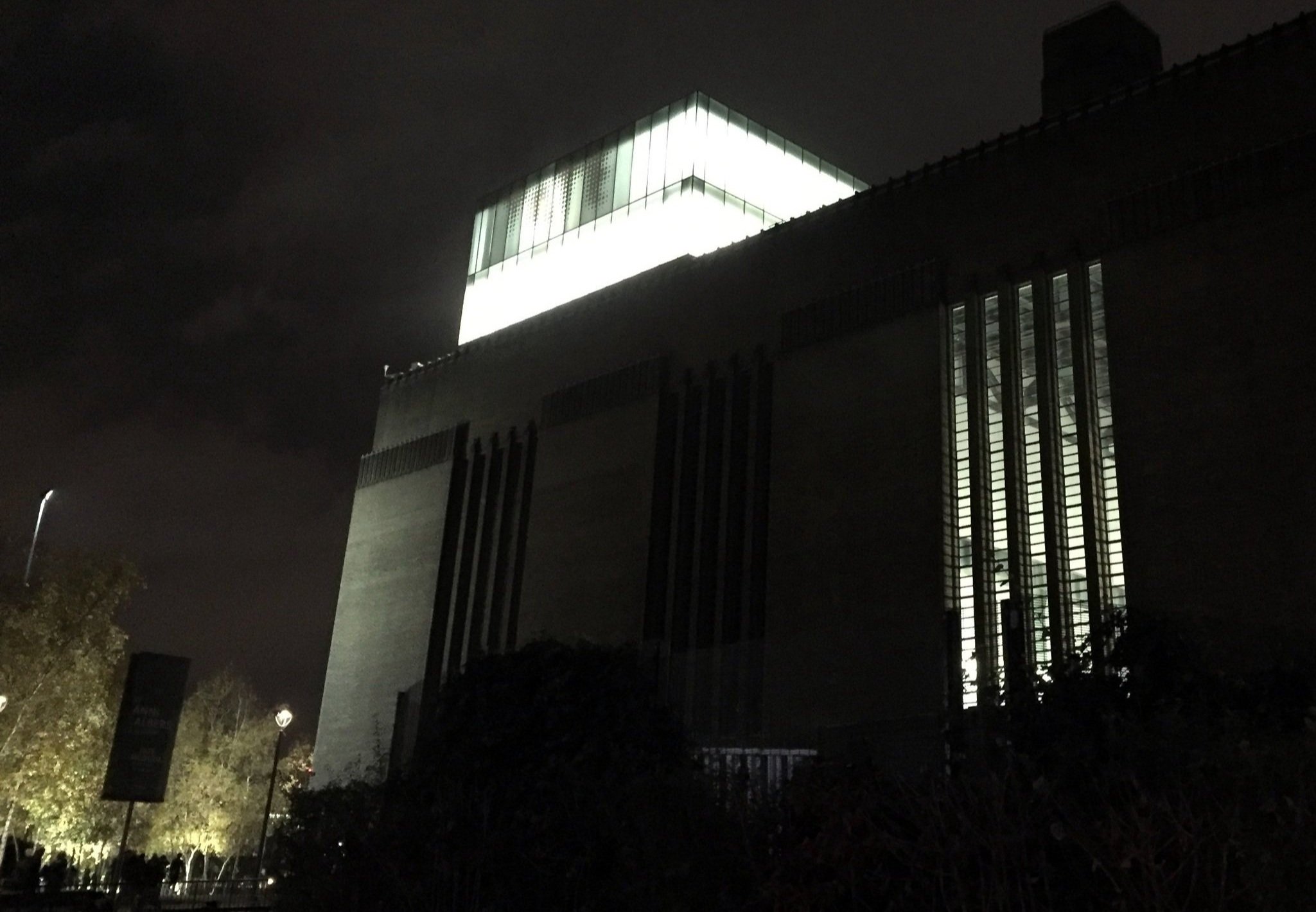
Function: Power station converted to art museum then extended
Architect: Sir Giles Gilbert Scott. Conversion and extension Herzog and de Meuron
Construction: 1947-1963 then 1995-2000 and 2010-2016
Location: Southwark, London
Psychological characteristics:
Traits of a more than human family: Embodying reparation and regeneration
‘Power over and power to’: Conscious and unconscious enactments;
Blind spots, unintended consequences and contradictions
Hauntings: Managing loss, mourning and melancholia;
Hauntings of Colonies and Empire
Transitional space: Space for play and creativity
Psychostructure Profiling (TATE MODERN)
Methods used :
Days of Action
Visual Matrix
A retrospective case study
This case study started from thinking about work done by our architect and artist collaboration in conducting the Days of Action event series commissioned by Tate. We decided to test our new methodology and apply it retrospectively to what transpired from those events along with findings from a more recent Visual Matrix. These methods can shed light on unconscious and unintended consequences of building heritage and design decisions and offer pointers for reparative change and innovation.
Traits of a more than human family Embodying reparation and regeneration
Tate Modern is a child of the older Tate Britain at Millbank and a younger sibling to Tate Liverpool and Tate St Ives. While they all have their own distinct characteristics, as members of the same family they also share many features, such as a mix of private and public funding and support. They share industrial heritage and waterside locations reclaimed and conserved for cultural regeneration.
The prison at Millbank that Tate Britain replaced was in a previously insalubrious area of industrial mills. The founding of the National Gallery of British Art, as Tate Britain was originally named, can be seen as an act of reparation, using private wealth to offer local regeneration of a deprived London riverbank that had been a place of sorrow, imprisonment, and exile.
With the passing of time and the end of Empire, Tate Britain matured and could overcome its ambivalence about giving a home to its international modern art collections. These significant collections were passed onto its offspring, Tate Modern, whose role it was to house and present them to a public audience in a radically new and bespoke setting.
‘Power over and power to’ Conscious and unconscious enactments
Different kinds of power and how they are enacted are key to the subjectivity of Tate Modern. Themes of ‘power over’ and ‘power to’ play out through the organisation and building's history and are embodied in its architecture. In the building’s previous incarnation as a power station, humans were there to service the power generating machines, dwarfed by their size, noise and power. The machines had both ‘power over’ people and literally offered ‘power to’ the people of London. Electrical power has been transformed into creative cultural power, mirroring the way that Britain has gone from industrial to cultural powerhouse, from political imperial dominance to international and multicultural influencer. Tate Modern makes a conscious effort to be a force for good. Unconscious aspects nonetheless can appear in what we think of as hauntings and blind spots.
Blind spots, unintended consequences and contradictions
There is a reparative gesture in the design of Tate Modern and more especially the Turbine Hall and Switch House that speak of offering 'power to' the people. Some of this 'power to' is characterized by reversals of expected hierarchies and by 'leaving enough flexibility and freedom for others to use and play with as they wish'1. As cultural products buildings mirror socio political thinking and dynamics – even when consciously intending not to – such as organising space hierarchically, with the most important at the highest point. The Switch House knowingly reverses this order by offering its public a space at the summit of its pyramidal form and then exerts the power of its form by providing a narrowing staircase or lift access to regulate the flow of people to the viewing deck. The terrace offers the public an elevated position and ‘power to’ look over the London landscape. But it also gave it ‘power over’ nearby glass-walled apartments overlooking and intruding into neighbours’ everyday lives. This was a blind spot that became an item of controversy and litigation, resulting in the closure of the west facing viewing platform oriented towards the penthouses; the architecture mirroring wider social antagonisms. It is almost as if a diagrammatic social pyramid, a desired inverted pyramid and a material architectural pyramid are in conflict. We wondered if these inversions of hierarchy and their tensions, built into the architecture, have exerted an influence on Tate Modern in other ways, and if so, how?
Through the 'Days of Action' method we discovered that many of Tate’s spaces are visually and aurally permeable: the gaps, voids and gorge like drops of the buildings’ spaces, created by drawn back floor plates offer connectivity and short circuits between levels, bridges, platforms and buildings. Visual and aural focal points are dispersed, and it is as if this web of connection challenges us to rethink how individual parts of the overall building can interact. This constitutes an architectural embodiment of the ‘power to’ interrelate and move across and between hierarchical divides. We ask can this be worked with more consciously through the strata of Tate's organisation and if so what would this involve?
Hauntings Managing loss, mourning and melancholia
The city continually presents its inhabitants with new buildings which may come to constitute an important psychic element in the population's relation to the old and the new. The power station designed by Sir Giles Gilbert Scott, son of Sir George Gilbert Scott, Gothic Revival architect, gives an architectural pedigree that acts as a deep formative influence for the building. The extent to which architects and commissioners embraced and worked with Tate Modern’s inherent characteristics to unite the old with the new determines what it is today. In order to accommodate a broad range of art, the architects Herzog & De Meuron replaced much of the power station’s interior with an understated aesthetic. The need to strip the building of its vast electrical generators and underground oil tanks, to provide galleries of differing sizes, is in tension with an anxiety to keep revealing the building’s industrial past. The architects’ desire to allow the former power station to speak, at scale and in form and material, can be seen and felt; in its original cathedral-like windows that span floor to ceiling, in the preservation of its brick skin and the rough circular concrete interiors of its former oil tanks, the heavy stair rails, cast iron grilles and unfinished wood floors. This impulse reflects a desire on the architects’ part to honour the former power station. But its heart is no longer a turbine nor its veins cables. There is both a strong presence of the past in its exterior appearance and a haunted absence in the Turbine Hall. This haunting is machinic in quality, felt by the absence of its generators yet present in its scale and steel infrastructure. The industrial past embodied in the fabric and stripped out volumes of the building may now affect our ability to form positive relations with it or with aspects of it. We ask whether any reluctance to let go of the past, when idealised, impedes a mourning process and leads to what psychotherapists call a melancholic reaction which may affect both architects and some building users.
The rationalist lines of the building's interior spaces and their lack of adornment can make people perceive the building as cold and hard, even alien according to some of our research participants. The black and grey colour palette invokes a blackened cathedral of power, smoking chimney, smoke-filled skies. But for a demographic who live in a different technological age the building’s industrial past, present in its hard surfaces and colour palette provide little warmth and comfort. Some of our participants appeared to desire more intimacy, warmth and colour. In that sense could the architects’ respect for the integrity of the building denote too strong an attachment to the industrial past? If this were more fully acknowledged, could it be used as a provocation for a more critical appraisal of that legacy and propose a third place of mediation between a power station and a museum? There are some answers in other parts of the building.
Ornament and adornment embodied in the original Art Deco brick work of the original 1940s power station were experienced more positively by our Visual Matrix participants. These are daringly and innovatively explored in the Switch House. These original decorative elements recur in the ten-storey tower built on the site of the old switch house of the power station, which is clad in an outer skin of latticed brickwork and folded surfaces. It is as if the hermetic and mute walls of the original building have been stretched around its surface creating perforations, to allow views, daylight in and night-time glow. The way in which visitors perceive the new and make a connection with the old is in this case positive. Brick and its ornamentation, often perceived as superfluous become an integrative element for understanding Tate Modern’s architecture, uniting the old and new.
Hauntings of Colonies and Empire
There are other hauntings from the past, such as its name Tate, shared with its progenitor Tate Britain. It takes us back to Henry Tate, the sugar industrialist who in 1889 provided funding to build a home for his own collection of art, housed firstly by Tate Britain and now additionally by Tate Modern. The Switch House extension renamed the Blavatnik building is named in recognition of another major donor, whose input dwarfed the public funding that made it possible. Both benefactors however made their money in industries that have had shadowy aspects. Tate’s wealth was indirectly linked to sugar plantation slavery; Blavatnik linked to oil and chemicals and international business controversies. The ghosts of those whose lives have been adversely affected by slavery and oil may well haunt us until we can more consciously acknowledge that unavoidable heritage. How can these ambivalent heritages best be worked with? Some reparation has been made by Tate in the renaming of the Boiler House in honour of their neighbour Natalie bell, a London SE1 resident, for her contribution to a youth and community programme at Coin Street. Could more be possible?
Transitional space Space for play and creativity
Tate Modern has consciously designed space for a new type of work which is at scale and experiential. The Turbine Hall and to a lesser extent the circulatory spaces of the Switch House potentially provide holding spaces or facilitating environments (ref) which are psychological as much as physical. They are places to practice and rehearse a more entangled existence with architecture and its objects. In that sense the intention can be interpreted as providing what psychologist Donald Winnicott would have termed ‘transitional space’, the space of play and creativity in childhood that underpins the capacity for cultural life in adulthood2.
The Turbine Hall particularly could be described as a space in-between the real and the fantastic, a liminal space, both a street and a gallery. It could be seen as a relational space in which the building and its (art) objects and viewer can interact imaginatively to construct something new. It is a place where spontaneous desires and unexpected encounters can flower. This space between is poised between inner and outer worlds, the real and the imaginary, the psychological and the material.
1 Jacques Herzog (2016) ‘Jacques Herzog and Pierre de Meuron in conversation with Chris Dercon’. In: Chris Dercon, Nicholas Serota (Eds.). ‘Tate Modern. Building a Museum for the 21st Century’, London: Tate Enterprises Ltd. pp.92-12. https://www.herzogdemeuron.com/writings/jacques-herzog-and-pierre-de-meuron-in-conversation-with-chris-dercon/
2 Donald Winnicott (1971) ‘Playing and Reality’, London: Tavistock Publications

